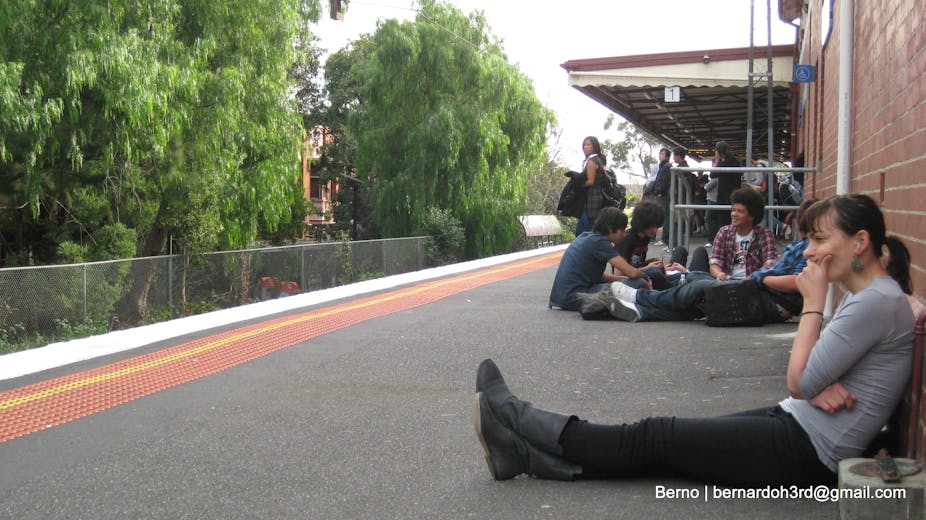The federal government’s proposed budget measures are particularly harsh on young people, particularly the most vulnerable. A raft of measures, if introduced, will reduce young people’s access to income support, to education and training and to employment.
It is proposed that young people under the age of 30 will have a six-month wait until they can access Newstart or Youth Allowance. The benefit will be available for six months only. The age of eligibility for the Newstart allowance will increase from 22 to 24 years and those aged between 22 and 24 will only be eligible for the Youth Allowance.
This amounts to a loss of just under A$50 a week compared with current arrangements. At the same time, funding has been withdrawn for the organisations that provide career counselling, including Youth Connections and the Local Learning and Employment Networks (in Victoria). Support for young people who are already vulnerable, including those with disabilities, will drop to a new low.
The justification for these harsh measures, according to federal treasurer Joe Hockey, is that they are necessary to balance the budget. This, according to Hockey, will, at a future time, enable the government to provide responsibly for the vulnerable, the poor, the disabled and the sick. Similarly, prime minister Tony Abbott argues that:
The budget pain will be temporary but the economic improvement will be permanent.
The problem with this logic is that it’s not that simple. The harms that are done cannot be retracted. Young lives cannot be relived.
Critical years: the evidence
This message comes across loud and clear from the Youth Research Centre’s longitudinal Life Patterns research program. Following a cohort of secondary school graduates of 1991, this research traced the impact on young people’s lives of two significant policy changes that occurred in the early 1990s: university fees and the Workplace Relations Act. These policies changed the rules of school-to-work transitions, and created the conditions for a new generation (Generation X).
It is well known that this generation were the pioneers of the “new youth”. The period that young people spend in educational institutions has extended into their mid-twenties. They have then spent the next 10–15 years seeking secure work before “settling down”.
What is not as well known is that Generation X also bore the costs of this new life stage of extended economic insecurity and dependence. Although the majority of the participants in the Life Patterns study said they expected to be in stable relationships or married and becoming parents by their late 20s, it was more than ten years later that the majority were economically secure enough to make these commitments.
Concerned about the drop in the fertility rate that its policy changes caused, the Howard government offered a baby bonus to encourage parenthood. This belated gesture is echoed in the current government’s assumption that young lives can be directed at the whim of political agendas.
In the wake of these events, members of Generation Y have largely accepted that it is up to the individual young person (and their family) to invest in education and learn how to navigate increasingly insecure labour markets. This works for some, but the evidence shows that for an increasing minority it is very difficult to work out what kind of education or training will be best and how to make this work in volatile labour markets. In other words, it’s already difficult for young people to get it right.

The report How Young People are Faring 2013 by the Foundation for Young Australians shows that it is taking young people longer to get from education to full-time work. Nearly one in four young women aged 23 and one in six young men are not in study or work.
The Life Patterns research also shows that financial hardship and combining work and study are associated with the trend towards declining mental health for young people aged 19 to 25. In other words, even now, many young people struggle against the odds to get educational or skills qualifications and to use these in the labour market. A proportion of those who do experience stress levels that are harmful to their health.
Increasing risk of a lost generation
Extended periods of poverty, unemployment, lack of access to meaningful and purposeful education or training and insecure work for 18- to 25-year olds robs them of the building blocks to make productive lives. The momentum lost during these crucial years is very difficult to recover.
These conditions, it is argued in the International Labour Organisation report Global Employment Trends for Youth 2013, are creating a “lost generation”, who lose hope. The scarring does not just affect young people. It also affects society in the form of intergenerational conflict and escalating welfare costs in the future.
A majority of young Australians have the social and material resources to survive and perhaps even thrive in these times. But a significant minority are already finding it tough. The proposed federal budget measures will effectively remove the threadbare social welfare safety net that provides a basic level of support for young people who, through no fault of their own, have little financial or social support, who have disabilities or health challenges.
The window of opportunity that exists at this stage of their lives closes as time passes. Economically and socially, Australia has a lot to gain by supporting young people during these significant years of their life. These years hold opportunities that young people need to take now. This time cannot be relived.
See the rest of the Another Country: Youth in Australia series here.

